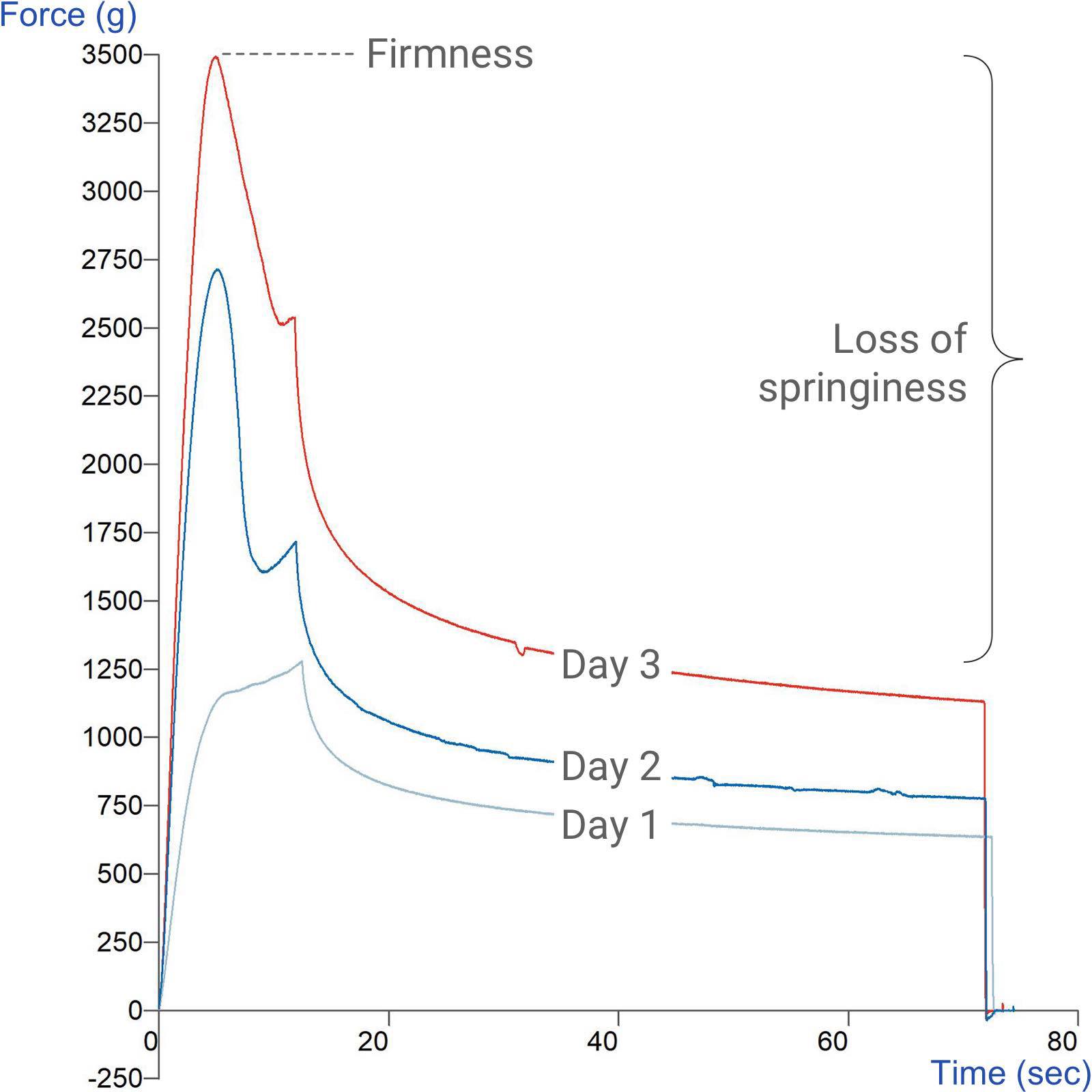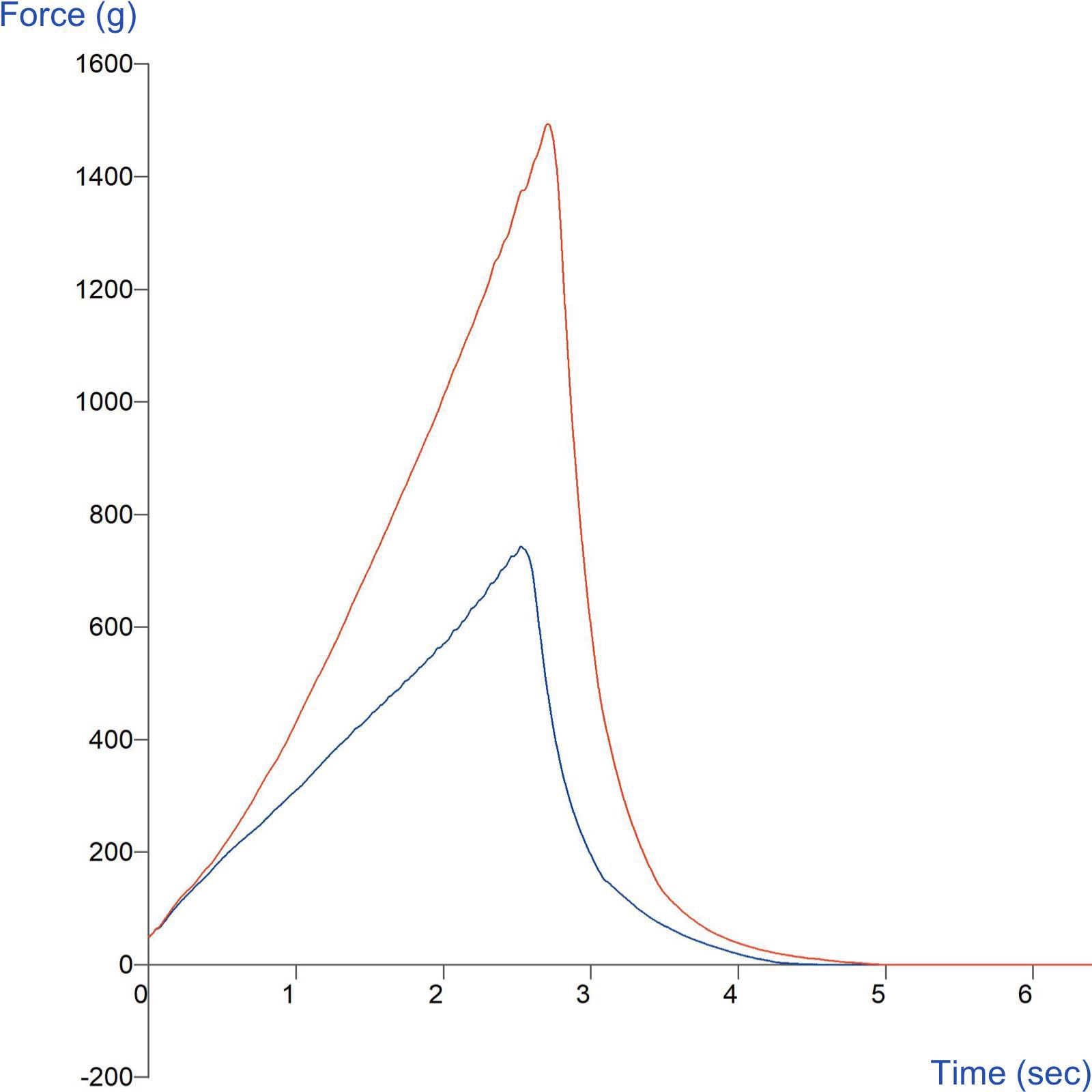How to measure springiness/recovery

Springiness/product recovery: definition and importance
Springiness and product recovery are key texture attributes that describe how well a material, especially in food products or soft materials, returns to its original shape or thickness after being compressed or deformed.
Springiness measures the elastic recovery of the material after a force is applied and removed. The rate of elastic recovery, is an important indicator of freshness in products like baked goods such as bread, cakes, confectionery and gels and an indication of quality and elasticity in non-food materials like rubbers, foams, and personal care products such as cosmetic sponges.
The Texture Analyser can assess springiness by compressing a product and monitoring its recovery. Product recovery refers to the degree to which a material regains its original form after being deformed by a compressive or tensile force. This concept overlaps with springiness but focuses on the total recovery of the product, especially over a longer period, rather than just the immediate elastic response.
Product recovery is especially important in materials like foams, rubbers, and certain gels where maintaining shape and integrity after compression or deformation is critical for product performance.
Further example applications of springiness testing
Springiness measurement using a Texture Analyser helps evaluate the elastic recovery of products in industries ranging from food processing to materials science. Below are key applications:
- Bakery product springiness testing: Springiness is a key quality attribute in fresh baked goods. Products like bread, muffins and sponge cakes are expected to have high springiness, bouncing back after being compressed and assessing how much they return to their original height after deformation.
- Gummy candy springiness measurement: Evaluating the springiness of gummy candies by compressing them and measuring their ability to return to their original shape after deformation.
- Foam material springiness analysis: Assessing the springiness of foam materials used in mattresses and cushions by compressing the foam and measuring its recovery to its original thickness is important to ensure that the foam can cushion products/people effectively and then recover its shape to be reused or maintain its structural integrity.
- Rubber and elastomer springiness measurement: Evaluating the springiness of rubber materials by measuring the recovery after compressing them in automotive or industrial applications. Rubber seals and gaskets must recover after compression to maintain tightness and prevent leaks in applications like plumbing or automotive engineering.
- Sponge material springiness evaluation: Measuring the springiness of sponge materials used in cleaning or cosmetics by compressing and testing their elastic recovery.
- Polymer springiness analysis: Testing the springiness of polymers used in manufacturing by compressing them and evaluating their ability to return to their original shape or thickness.
In these examples, a Texture Analyser applies controlled forces to assess the springiness of products, providing essential insights into texture, quality, and performance.
Typical probe/attachment used for measurement
In a typical springiness/product recovery test, a compression test measures how well a material returns to its original state after being deformed or stressed. This can be done as a single compression test returning immediately at the same speed, a single compression where a distance is held for a chosen time and the force response measured, or a multiple compression test.
Typical comparison of samples
How to interpret the Texture Analyser graph
Several texture analysis techniques are used to measure springiness and product recovery.
 Typical curve indicating key analysis points of a springiness - single compression test
Typical curve indicating key analysis points of a springiness - single compression test
Single compression test with immediate return at same speed
When measuring springiness/product recovery in this way, the force vs distance/time graph springiness is indicated by the ratio of work of the compression vs decompression regions of the curve. From the graph you can observe/obtain the following:
- Springiness
- Elasticity
- Elastic recovery
Single compression test holding distance for chosen time
 Typical curve indicating key analysis points of a springiness - single compression holding distance test
Typical curve indicating key analysis points of a springiness - single compression holding distance test
Multi-cycle compression test
 Typical curve indicating key analysis points of a springiness - multi cycle compression test
Typical curve indicating key analysis points of a springiness - multi cycle compression test
A full explanation of these curves and their analysis can be accessed within Exponent Connect software. Existing Exponent users can upgrade to Exponent Connect specification.
Below is a video example of how we can help you understand curve analysis for an example property.
Key factors affecting springiness/recovery measurement
- Temperature and humidity: Temperature and humidity can significantly influence springiness measurements, as they affect the material's elasticity and recovery properties. Higher temperatures may soften materials, reducing springiness and recovery, while cooler temperatures tend to make materials more elastic, increasing their ability to spring back after deformation.
- Test speed: The rate at which the sample is compressed and allowed to recover can affect the measured springiness, as some materials may respond differently to varying deformation speeds.
- Compression distance: The extent to which a sample is compressed during testing influences the springiness measurement, as different materials may have varying capacities for recovery at different levels of deformation.
- Wait time between compressions: The duration allowed for the sample to recover between compression cycles can significantly affect springiness measurements, especially for materials that require more time to return to their original state.
- Sample preparation: Consistent and appropriate preparation methods are crucial for accurate springiness measurements, as variations in preparation can lead to inconsistent results.
- Probe geometry: The shape and size of the probe used in testing can impact how the force is applied and distributed, affecting the measured springiness.
- Aging and staling: In food products, staling or drying reduces springiness, making the product less elastic and reducing its ability to recover after being compressed.
Collecting additional measurements during your test
Alternatively, a Texture Profile Analysis (TPA) test can measure chewiness amongst its parameters but this is from a compression test using a larger cylinder probe.
Optimising springiness/recovery measurement and analysis: The Stable Micro Systems advantage
The Stable Micro Systems Texture Analyser excels in optimising springiness and product recovery measurements through its comprehensive approach and advanced features. It offers precise quantification of springiness, accurately measuring the rate at which a deformed material returns to its undeformed state.
The Texture Analyser captures detailed force-time-distance profiles and coupled with Exponent Connect software allows for measuring various properties related to springiness, including elasticity and elastic recovery, across a wide range of products, enabling researchers to calculate how close a product is to a 'perfect spring'.
Backed by Stable Micro Systems' expertise in graphical interpretation and method development, makes the Texture Analyser the ideal choice for researchers and manufacturers seeking to refine product formulations and maintain quality standards in springiness and product recovery testing across various industries.
A choice of compression probes to imitate consumer interaction.
Comprehensive analysis of graph features providing multiple parameters.
Ability to additionally capture synchronised video for better understanding of product behaviour.
Adjust settings to match specific product requirements or simulate real-world usage conditions.
If you need help with your recovery force measurement, we offer unrivalled support.
Be guided through the steps to successful testing and analysis of springiness/recovery.







